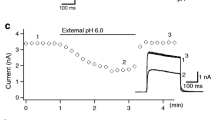Abstract.
The bee venom toxin apamin is an important drug tool for characterising small conductance Ca2+-activated K+ channels (SK channels). In recombinant expression systems both rSK2 and rSK3 channels are potently blocked by apamin, whilst the sensitivity of SK1 channels is somewhat less clear. In the present study we have conducted a detailed analysis by patch clamp electrophysiology of the effects of apamin on human SK channels (SK1, SK2 and SK3) stably expressed in Chinese hamster ovary (CHO-K1) cells.
CHO-K1 cell lines expressing either hSK1, 2 or 3 channels were first validated using specific antibodies and Western blotting. Specific protein bands of a size corresponding to the predicted channel tetramer (~250–290 kDa) were detected. In each cell line, but not wild-type untransfected cells, large, time-independent inwardly rectifying Ca2+-dependent K+ currents were observed under voltage-clamp. In CHO-hSK1, this current was markedly reduced by apamin (IC50 value 8 nM), however, a significant fraction of the current remained unblocked (39±5%), even at saturating concentrations (1 µM apamin). The apamin-sensitive and -insensitive currents possess very similar biophysical and pharmacological properties. Each are Ca2+-dependent, inwardly rectify and have relative ionic permeabilities of K+>Cs+>Li+=Na+. Both components were resistant to block by charybdotoxin and iberiotoxin, known IK and BK channel blockers, but were attenuated by the tricyclic antidepressant cyproheptadine (>95% block at 1 mM). The SK channel opener 1-EBIO could still produce channel activation in the presence of apamin. Importantly, hSK2 and hSK3 channels also exhibit partial apamin sensitivity in our experimental paradigm (IC50 values of 0.14 nM and 1.1 nM, respectively, and maximal percentage inhibition values of 47±7% and 58±9%, respectively).
Our data indicate that, at least in a recombinant expression system, all three SK channels can be partially apamin-sensitive. The explanation for this finding is presently unclear but may be due to regulatory subunits, phosphorylation or other types of post translational modification. Ascribing particular SK channels to physiological roles using apamin as a drug tool needs to be done cautiously in light of these findings.
Similar content being viewed by others
Author information
Authors and Affiliations
Additional information
Electronic Publication
Rights and permissions
About this article
Cite this article
Dale, .T., Cryan, .J., Chen, .M. et al. Partial apamin sensitivity of human small conductance Ca2+-activated K+ channels stably expressed in Chinese hamster ovary cells. Naunyn-Schmiedeberg's Arch Pharmacol 366, 470–477 (2002). https://doi.org/10.1007/s00210-002-0622-2
Received:
Accepted:
Issue Date:
DOI: https://doi.org/10.1007/s00210-002-0622-2




